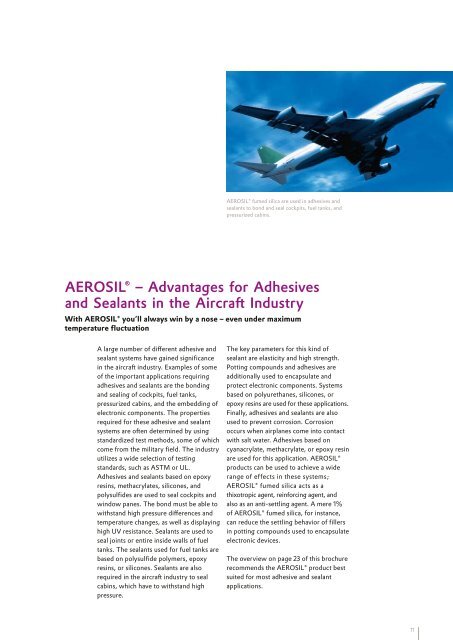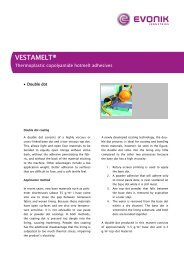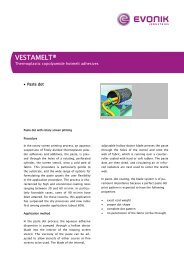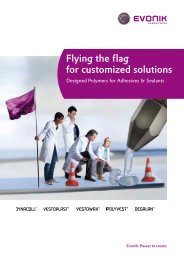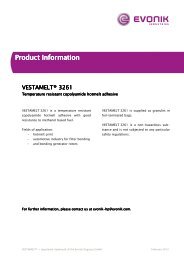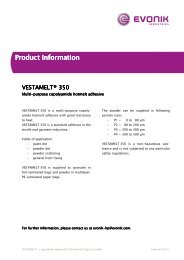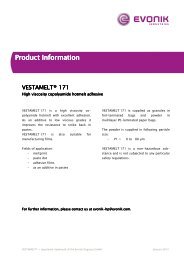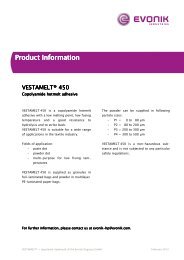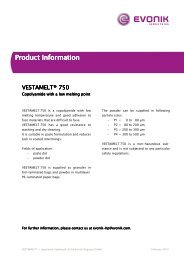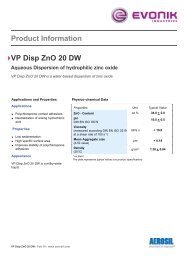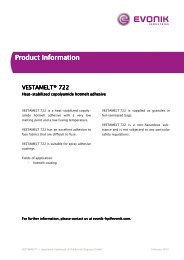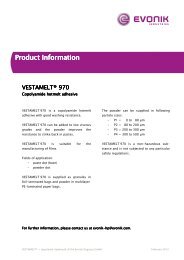AEROSIL® for Adhesives and Sealants - Adhesives & Sealants by ...
AEROSIL® for Adhesives and Sealants - Adhesives & Sealants by ...
AEROSIL® for Adhesives and Sealants - Adhesives & Sealants by ...
- No tags were found...
Create successful ePaper yourself
Turn your PDF publications into a flip-book with our unique Google optimized e-Paper software.
<strong>AEROSIL®</strong> fumed silica are used in adhesives <strong>and</strong>sealants to bond <strong>and</strong> seal cockpits, fuel tanks, <strong>and</strong>pressurized cabins.<strong>AEROSIL®</strong> – Advantages <strong>for</strong> <strong>Adhesives</strong><strong>and</strong> <strong>Sealants</strong> in the Aircraft IndustryWith <strong>AEROSIL®</strong> you’ll always win <strong>by</strong> a nose – even under maximumtemperature fluctuationA large number of different adhesive <strong>and</strong>sealant systems have gained significancein the aircraft industry. Examples of someof the important applications requiringadhesives <strong>and</strong> sealants are the bonding<strong>and</strong> sealing of cockpits, fuel tanks,pressurized cabins, <strong>and</strong> the embedding ofelectronic components. The propertiesrequired <strong>for</strong> these adhesive <strong>and</strong> sealantsystems are often determined <strong>by</strong> usingst<strong>and</strong>ardized test methods, some of whichcome from the military field. The industryutilizes a wide selection of testingst<strong>and</strong>ards, such as ASTM or UL.<strong>Adhesives</strong> <strong>and</strong> sealants based on epoxyresins, methacrylates, silicones, <strong>and</strong>polysulfides are used to seal cockpits <strong>and</strong>window panes. The bond must be able towithst<strong>and</strong> high pressure differences <strong>and</strong>temperature changes, as well as displayinghigh UV resistance. <strong>Sealants</strong> are used toseal joints or entire inside walls of fueltanks. The sealants used <strong>for</strong> fuel tanks arebased on polysulfide polymers, epoxyresins, or silicones. <strong>Sealants</strong> are alsorequired in the aircraft industry to sealcabins, which have to withst<strong>and</strong> highpressure.The key parameters <strong>for</strong> this kind ofsealant are elasticity <strong>and</strong> high strength.Potting compounds <strong>and</strong> adhesives areadditionally used to encapsulate <strong>and</strong>protect electronic components. Systemsbased on polyurethanes, silicones, orepoxy resins are used <strong>for</strong> these applications.Finally, adhesives <strong>and</strong> sealants are alsoused to prevent corrosion. Corrosionoccurs when airplanes come into contactwith salt water. <strong>Adhesives</strong> based oncyanacrylate, methacrylate, or epoxy resinare used <strong>for</strong> this application. <strong>AEROSIL®</strong>products can be used to achieve a widerange of effects in these systems;<strong>AEROSIL®</strong> fumed silica acts as athixotropic agent, rein<strong>for</strong>cing agent, <strong>and</strong>also as an anti-settling agent. A mere 1%of <strong>AEROSIL®</strong> fumed silica, <strong>for</strong> instance,can reduce the settling behavior of fillersin potting compounds used to encapsulateelectronic devices.The overview on page 23 of this brochurerecommends the <strong>AEROSIL®</strong> product bestsuited <strong>for</strong> most adhesive <strong>and</strong> sealantapplications.11


